UNDERSTANDING THE RESILIENT FAIRFAX PLAN
The Resilient Fairfax Plan is part of the county's comprehensive efforts to combat climate change. While the Community-wide Energy and Climate Action Plan focuses on reducing emissions, Resilient Fairfax is designed to address the local impacts of climate change such as flooding, extreme heat and storms.
"Resilient Fairfax focuses on building the county's ability to bounce back from climatic shocks and stressors without irreversible loss,” says Homer. “By implementing resilience-focused policies, we aim to mitigate the impacts of climate change and ensure a more resilient future for our residents."
KEY PILLARS OF THE PLAN
The Resilient Fairfax Plan consists of 48 strategies organized into four pillars:
- Resilient infrastructure and buildings: This involves enhancing the resilience of infrastructure managed directly by the county, as well as partnering with external organizations to upgrade infrastructure. The focus is on reducing vulnerability to hazards like flooding and power outages.
- Climate-ready communities: The goal is to ensure that communities have better access to existing services aimed at enhancing resilience. Examples include financial assistance for air conditioning and flooding-related help.
- Adaptive environments: This pillar emphasizes the importance of maintaining and protecting natural resources such as wetlands and urban forestry, which naturally provide resilience against climate risks.
- Integrated action planning: Setting a strong foundation for success through proper funding, interagency coordination, legislation and data management ensures effective implementation of the plan.
Developing the Resilient Fairfax Plan was an intensive process involving collaboration with more than 25 departments and 150 staff members.
"The planning process involved analyzing local climate data, such as changing precipitation patterns and increased temperatures. This helped us understand the specific climate-related challenges in Fairfax County."

THE COMMUNITY'S ROLE
While the county government plays a crucial role in implementing the Resilient Fairfax Plan, you can contribute too. Homer suggests practical actions like reducing impervious surfaces on properties to improve water absorption, planting native or resilient trees to combat urban heat islands, reporting flooding incidents and applying for cooling assistance programs.
Homer also highlights the importance of social connections.
"Communities that are socially connected are more resilient. Get to know your neighbors, as strong social ties can help ensure that fewer people are left behind during climate-related events."
THE COUNTY CONVERSATION PODCAST
The “County Conversation” is a podcast featuring employees and subject matter experts from the Fairfax County Government discussing programs, services and items of interest to residents of Fairfax County. Click here to listen to past episodes of "County Conversation.” To find other county podcasts, visit www.fairfaxcounty.gov/podcasts.





 SIGN UP FOR DAILY EMAIL HEADLINES
SIGN UP FOR DAILY EMAIL HEADLINES